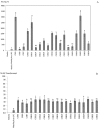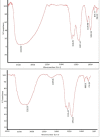Production of humic substances through coal-solubilizing bacteria
- PMID: 25477925
- PMCID: PMC4204976
- DOI: 10.1590/s1517-83822014000300021
Production of humic substances through coal-solubilizing bacteria
Abstract
In this paper, the production of humic substances (HS) through the bacterial solubilization of low rank coal (LRC) was evaluated. The evaluation was carried out by 19 bacterial strains isolated in microenvironments with high contents of coal wastes. The biotransformed LRC and the HS produced were quantified in vitro in a liquid growth medium. The humic acids (HA) obtained from the most active bacterial strain were characterized via elemental composition (C, H, N, O), IR analyses, and the E4/E6 ratio; they were then compared with the HA extracted chemically using NaOH. There was LRC biotransformation ranged from 25 to 37%, and HS production ranged from 127 to 3100 mg . L(-1). More activity was detected in the isolated strains of Bacillus mycoides, Microbacterium sp, Acinetobacter sp, and Enterobacter aerogenes. The HA produced by B. mycoides had an IR spectrum and an E4/E6 ratio similar to those of the HA extracted with NAOH, but their elemental composition and their degree of aromatic condensation was different. Results suggest that these bacteria can be used to exploit the LRC resulting from coal mining activities and thus produce HS in order to improve the content of humified organic matter in soils.
Keywords: Acinetobacter baumannii; Bacillus mycoides; Enterobacter aerogenes; Microbacterium sp; low rank coal.
Figures




References
-
- Alloway BJ. Heavy Metals in Soils. 2nd ed. Blackie Academia Professional; London: 1995.
-
- Badis A, Ferradji FZ, Boucherit A, Fodil D, Boutoumi H. Characterization and biodegradation of soil humic acids and preliminary identification of decolorizing actinomycetes at Mitidja plain soil (Algeria) Afr J Microbiol Res. 2009;3(13):997–1007.
-
- Bandeira M, Mosca G, Vamerali T. Humic acids affect root characteristics of fodder radish (Raphanus sativus L. var. oleiformis Pers.) in metal-polluted wastes. Desalination. 2009;246(1–3):78–91.
-
- Barros L, Canellas LP, Lopes F, Oliveira N, Lazaro E, Piccolo A. Bioactivity of chemically transformed humic matter from vermicompost on plant root growth. J Agric Food Chem. 2010;58(6):3681–3688. - PubMed
-
- Canellas LP, Dantas L, Aguiar N, Peres L, Zsogon A, Olivares F, Dobbss L, Facanha A, Nebbioso A, Piccolo A. Probing the hormonal activity of fractionated molecular humic components in tomato auxin mutants. Ann Appl Biol. 2011;159(2):202–211.
Publication types
MeSH terms
Substances
LinkOut - more resources
Full Text Sources
Other Literature Sources
